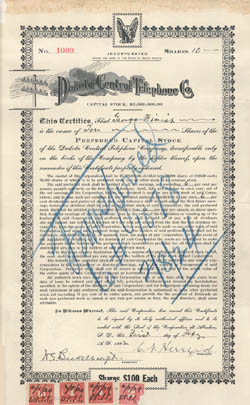Telecommunications History Group Resources
Telephone Company Histories
Dakota Central Telephone Company
 Location: Aberdeen, South Dakota
Location: Aberdeen, South Dakota
Started: 1898
Sold to/Ended: Minnesota based Tri-State Telephone Company purchased in 1928, NWB purchased Tri-State in 1934.
History: This may be one of the most interesting telephone companies in the American West. German born John L. W. Zietlow is the heart of the story.
Zietlow, a farmer’s son, had resigned himself to the life of manual labor until a sawmill accident cost him his right arm. While in the hospital recuperating from the loss of his arm, he was informed that his bank failed and his life savings were gone. The sawmill helped pay for a six-month course at a business college, where John learned bookkeeping, penmanship and business law. He returned to the sawmill where he soon became superintendent.
In 1880, Zietlow became a manager at the Northwestern Manufacturing & Car Company. Convicts made up part of the company’s workforce. He made friends with Charles Emner, a gifted electrician and a convict. The two men began to play around with a new invention called the telephone, and improved the transmission quality of a couple of mail order phones they’d purchased. After reading a newspaper account of a Ferdinand Zietlow in the Dakota Territory who was badly burned, John went to the Territory and found that the burn victim was his estranged father. The father died and John moved his family from Minnesota to claim the Zietlow homestead. Homestead life was hard for a one-armed farmer.
John received a letter from his convict friend, Emner, who was now a successful real estate man in Washington, D.C. Because of some inside information he’d picked up, Emner suggested that Zietlow get into the telephone business. With Emner’s help, he started the Dakota Emner Telephone Company in September 1886, and the Aberdeen Telephone Company a month later. These companies were combined into Dakota Central in 1898.
Zietlow was a sharp businessman, a natural promoter and an excellent mechanic. Dakota Central grew quickly and John connected all of his exchanges with toll lines, thus beginning a long distance network. But the main thing he did was to stay out of the Bell Company’s patent infringement game, the game that had crushed the Western Union Company, Thomas Edison and everyone else in court.
Zietlow read about an inventor in his native Germany who had invented a sound transmission device 20 years before A. B. Bell. Philip Reis had built a machine that transmitted musical notes over a wire, but was never able to transmit understandable language. The Reis phone used different electronic principles than Bell’s. John tinkered with his own version of the Reis phone and found that a slight adjustment in the original wiring made it transmit understandable language very well. John patented his phone and began to use it throughout his growing system. As Dakota Central kept growing and was very profitable, it became very attractive to AT&T. AT&T tried unsuccessfully to buy Zietlow out, so they took Dakota Central to court, also to no avail. AT&T sent agents into South Dakota to secretly buy Dakota Central stock, but Zietlow found out who they were and had them run out of the state.
After John died in 1922, Dakota Central’s management lost its cohesiveness, and in 1928, was purchased at $200 a share by a non-Bell company, Tri-State Telephone. The problem was that like so many other “independent companies” in this part of the nation, Tri-State was deeply in debt and vulnerable to a buyout by NWB. In 1934, NWB officially bought Tri-State.
Casper Yost had always recognized Zietlow as, “one of the best telephone men in the nation,” and Dakota Central and NWB always had a friendly relationship.
